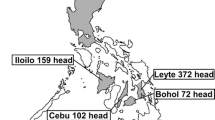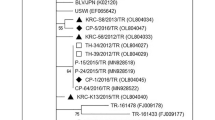Abstract
Bovine leukemia virus (BLV) is a member of the genus Deltaretrovirus of the family Retroviridae and cause a chronic lymphosarcoma, which is extensive in cattle. In yaks (Bos grunniens), the distribution, strains and genetic characteristics of BLV have rarely been studied. The aim of our study was to investigate BLV infections in domestic yaks and determine the genetic variability of BLV circulating in a region of the Qinghai Tibet Plateau, China. Blood samples were collected from 798 yaks, which were from different farms from Gansu, Qinghai and Sichuan provinces surrounding the Qinghai-Tibet Plateau. Nested PCR targeting BLV long terminal repeats was used to detect the BLV provirus. The highest prevalence of BLV infection was in Gansu province, where it was 18.93% (39/206) in white yaks from Tianzhu City and 19.14% (31/162) in black yaks from Gannan City. In Qinghai and Sichuan provinces, the prevalence of BLV in black yaks was 14.83% (35/236) and 14.94% (29/194), respectively. The prevalence of BLV was not significantly different in yaks up to one year old than in older animals. Phylogenetic analysis was performed using 16 different env-gp51 (497-bp) gene sequences from the three provinces and 71 known BLV strains, which revealed that in both Gansu and Qinghai provinces, genotypes 6 and 10 of the BLV strains were at high levels, whereas only genotype 10 was prevalent in Sichuan Province. Phylogenetic analysis and sequence comparisons revealed 95.7-99.8% sequence identity among the full-length env genes of 16 strains, nearly full-length genome sequences of six BLV strains, and those of the known genotypes 6 and 10 of BLV. This study provides comprehensive information is regarding the widespread infection of domestic yaks with BLV on the Qinghai-Tibet Plateau of China, and shows that at least two BLV genotypes (genotypes 6 and 10) are circulating in this population.







Similar content being viewed by others
References
Kettmann R, Portetelle D, Mammerickx M, Cleuter Y, Dekegel D, Galoux M, Ghysdael J, Burny A, Chantrenne H (1976) Bovine leukemia virus: an exogenous RNA oncogenic virus? Modern trends in human leukemia II. Springer, Berlin, pp 375–389
Willems L, Burny A, Collete D, Dangoisse O, Dequiedt F, Gatot J-S, Kerkhofs P, Lefebvre L, Merezak C, Peremans T (2000) Genetic determinants of bovine leukemia virus pathogenesis. AIDS Res Hum Retroviruses 16(16):1787–1795
Moratorio G, Obal G, Dubra A, Correa A, Bianchi S, Buschiazzo A, Cristina J, Pritsch O (2010) Phylogenetic analysis of bovine leukemia viruses isolated in South America reveals diversification in seven distinct genotypes. Arch Virol 155(4):481–489
Burny A, Cleuter Y, Kettmann R, Mammerickx M, Marbaix G, Portetelle D, Van den Broeke A, Willems L, Thomas R (1988) Bovine leukaemia: facts and hypotheses derived from the study of an infectious cancer. Vet Microbiol 17(3):197–218
Polat M, Ohno A, S-n Takeshima, Kim J, Kikuya M, Matsumoto Y, Mingala CN, Onuma M, Aida Y (2015) Detection and molecular characterization of bovine leukemia virus in Philippine cattle. Arch Virol 160(1):285–296
Llames L, Goyache J, Domenech A, Arjona A, Suarez G, Gomez-Lucia E (2001) Evaluation of virus excretion by cells persistently infected with the bovine leukaemia virus (BLV) using monoclonal antibodies. J Clin Virol 22(1):31–39
Polat M, Moe HH, Shimogiri T, Moe KK, S-n Takeshima, Aida Y (2017) The molecular epidemiological study of bovine leukemia virus infection in Myanmar cattle. Arch Virol 162(2):425–437
Schwartz I, Levy D (1994) Pathobiology of bovine leukemia virus. Vet Res 25(6):521–536
Gutiérrez G, Alvarez I, Politzki R, Lomónaco M, Santos MJD, Rondelli F, Fondevila N, Trono K (2011) Natural progression of bovine leukemia virus infection in Argentinean dairy cattle. Vet Microbiol 151(3):255–263
Aida Y, Murakami H, Takahashi M, Takeshima S-N (2013) Mechanisms of pathogenesis induced by bovine leukemia virus as a model for human T-cell leukemia virus. Front Microbiol 4:328
Gillet N, Florins A, Boxus M, Burteau C, Nigro A, Vandermeers F, Balon H, Bouzar A-B, Defoiche J, Burny A (2007) Mechanisms of leukemogenesis induced by bovine leukemia virus: prospects for novel anti-retroviral therapies in human. Retrovirology 4(1):18
Mamoun R, Astier T, Guillemain B, Duplan J (1983) Bovine lymphosarcoma: expression of BLV-related proteins in cultured cells. J Gen Virol 64(9):1895–1905
Zarkik S, Decroly E, Wattiez R, Seidah NG, Burny A, Ruysschaert J-M (1997) Comparative processing of bovine leukemia virus envelope glycoprotein gp72 by subtilisin/kexin-like mammalian convertases. FEBS Lett 406(1–2):205–210
Bai L, Otsuki H, Sato H, Kohara J, Isogai E, S-n Takeshima, Aida Y (2015) Identification and characterization of common B cell epitope in bovine leukemia virus via high-throughput peptide screening system in infected cattle. Retrovirology 12(1):106
Callebaut I, Voneche V, Mager A, Fumiere O, Krchnak V, Merza M, Zavada J, Mammerickx M, Burny A, Portetelle D (1993) Mapping of B-neutralizing and T-helper cell epitopes on the bovine leukemia virus external glycoprotein gp51. J Virol 67(9):5321–5327
Johnston ER, Radke K (2000) The SU and TM envelope protein subunits of bovine leukemia virus are linked by disulfide bonds, both in cells and in virions. J Virol 74(6):2930–2935
Mamoun R, Morisson M, Rebeyrotte N, Busetta B, Couez D, Kettmann R, Guillemain B (1990) Sequence variability of bovine leukemia virus env gene and its relevance to the structure and antigenicity of the glycoproteins. J Virol 64(9):4180–4188
Bruck C, Mathot S, Portetelle D, Berte C, Franssen J-D, Herion P, Burny A (1982) Monoclonal antibodies define eight independent antigenic regions on the bovine leukemia virus (BLV) envelope glycoprotein gp51. Virology 122(2):342–352
Khudhair YI, Hasso SA, Yaseen NY, Al-Shammari AM (2016) Serological and molecular detection of bovine leukemia virus in cattle in Iraq. Emerg Microb Infect 5(6):e56
Lee E, Kim E-J, Ratthanophart J, Vitoonpong R, Kim B-H, Cho I-S, Song J-Y, Lee K-K, Shin Y-K (2016) Molecular epidemiological and serological studies of bovine leukemia virus (BLV) infection in Thailand cattle. Infect Genet Evol 41:245–254
Polat M, S-n Takeshima, Hosomichi K, Kim J, Miyasaka T, Yamada K, Arainga M, Murakami T, Matsumoto Y, Diaz VB (2016) A new genotype of bovine leukemia virus in South America identified by NGS-based whole genome sequencing and molecular evolutionary genetic analysis. Retrovirology 13(1):4
Rodriguez SM, Golemba MD, Campos RH, Trono K, Jones LR (2009) Bovine leukemia virus can be classified into seven genotypes: evidence for the existence of two novel clades. J Gen Virol 90(11):2788–2797
Sun W-W, Lv W-F, Cong W, Meng Q-F, Wang C-F, Shan X-F, Qian A-D (2015) Mycobacterium avium subspecies paratuberculosis and bovine leukemia virus seroprevalence and associated risk factors in commercial dairy and beef cattle in northern and northeastern China. BioMed Res Int 2015:315173. https://doi.org/10.1155/2015/315173
Ma J-G, Zheng W-B, Zhou D-H, Qin S-Y, Yin M-Y, Zhu X-Q, Hu G-X (2016) First report of bovine leukemia virus infection in yaks (Bos mutus) in China. BioMed Res Int 2016:9170167. https://doi.org/10.1155/2016/9170167
Xu F, Pan Y, Wang M, Wu X, Tian L, Baloch AR, Zeng Q (2016) First detection of ungulate tetraparvovirus 1 (bovine hokovirus 1) in domestic yaks in northwestern China. Arch Virol 161(1):177–180
Xu F, Pan Y, Baloch AR, Tian L, Wang M, Na W, Ding L, Zeng Q (2014) Hepatitis E virus genotype 4 in yak, northwestern China. Emerg Infect Dis 20(12):2182
Zhu W, Dong J-B, Zhang J, Uchida K, K-i Watanabe, Goto Y, Haga T (2013) Bos grunniens papillomavirus type 1: a novel deltapapillomavirus associated with fibropapilloma in yak. J Gen Virol 94(1):159–165
Tajima S, Ikawa Y, Aida Y (1998) Complete bovine leukemia virus (BLV) provirus is conserved in BLV-infected cattle throughout the course of B-cell lymphosarcoma development. J Virol 72(9):7569–7576
Tamura K, Peterson D, Peterson N, Stecher G, Nei M, Kumar S (2011) MEGA5: molecular evolutionary genetics analysis using maximum likelihood, evolutionary distance, and maximum parsimony methods. Mol Biol Evol 28(10):2731–2739
Saitou N, Nei M (1987) The neighbor-joining method: a new method for reconstructing phylogenetic trees. Mol Biol Evol 4(4):406–425
Balić D, Lojkić I, Periškić M, Bedeković T, Jungić A, Lemo N, Roić B, Čač Ž, Barbić L, Madić J (2012) Identification of a new genotype of bovine leukemia virus. Arch Virol 157(7):1281–1290
Matsumura K, Inoue E, Osawa Y, Okazaki K (2011) Molecular epidemiology of bovine leukemia virus associated with enzootic bovine leukosis in Japan. Virus Res 155(1):343–348
Suh GH, Lee JC, Lee CY, Hur TY, Son DS, Ahn BS, Kim NC, Lee CG (2005) Establishment of a bovine leukemia virus-free dairy herd in Korea. J Vet Sci 6(3):227–230
Schoepf K, Kapaga A, Masami H, Hyera J (1997) Serological evidence of the occurrence of enzootic bovine leukosis (EBL) virus infection in cattle in Tanzania. Trop Anim Health Prod 29(1):15–19
Licursi M, Inoshima Y, Wu D, Yokoyama T, González ET, Sentsui H (2002) Genetic heterogeneity among bovine leukemia virus genotypes and its relation to humoral responses in hosts. Virus Res 86(1):101–110
Portetelle D, Couez D, Bruck C, Kettmann R, Mammerickx M, Van Der Maaten M, Brasseur R, Burny A (1989) Antigenic variants of bovine leukemia virus (BLV) are defined by amino acid substitutions in the NH2 part of the envelope glycoprotein gp51. Virology 169(1):27–33
Zhao X, Buehring GC (2007) Natural genetic variations in bovine leukemia virus envelope gene: possible effects of selection and escape. Virology 366(1):150–165
Gatot J-S, Callebaut I, Van Lint C, Demonté D, Kerkhofs P, Portetelle D, Burny A, Willems L, Kettmann R (2002) Bovine leukemia virus SU protein interacts with zinc, and mutations within two interacting regions differently affect viral fusion and infectivity in vivo. J Virol 76(16):7956–7967
Bruck C, Portetelle D, Burny A, Zavada J (1982) Topographical analysis by monoclonal antibodies of BLV-gp51 epitopes involved in viral functions. Virology 122(2):353–362
Author information
Authors and Affiliations
Corresponding author
Ethics declarations
Funding
This work was supported by a Grant from the National Natural Science Foundation of China (no. 31260616); Fuxi Foundation of Exceptional Talent at Gansu Agricultural University; Scientific Research Foundation for the New Scholars, Gansu Agricultural University (no. GSAU-RCZX201702) and the Innovation Foundation of the College of Veterinary Medicine, Gansu Agriculture University (no. JYCX-KX017).
Conflict of interest
The authors declare that there are no competing interests regarding the publication of this paper.
Ethical approval
All animals were handled with the assistance of veterinarians from the local veterinary institute and animal health and epidemiology centre. All procedures in this study were approved in strict accordance with good animal practice following the guidelines of the Animal Care and Use Committee of Gansu Agricultural University and performed in accordance with animal welfare and ethics.
Additional information
Handling Editor: Diego G. Diel.
Rights and permissions
About this article
Cite this article
Wang, M., Wang, Y., Baloch, A.R. et al. Molecular epidemiology and characterization of bovine leukemia virus in domestic yaks (Bos grunniens) on the Qinghai-Tibet Plateau, China. Arch Virol 163, 659–670 (2018). https://doi.org/10.1007/s00705-017-3658-9
Received:
Accepted:
Published:
Issue Date:
DOI: https://doi.org/10.1007/s00705-017-3658-9




